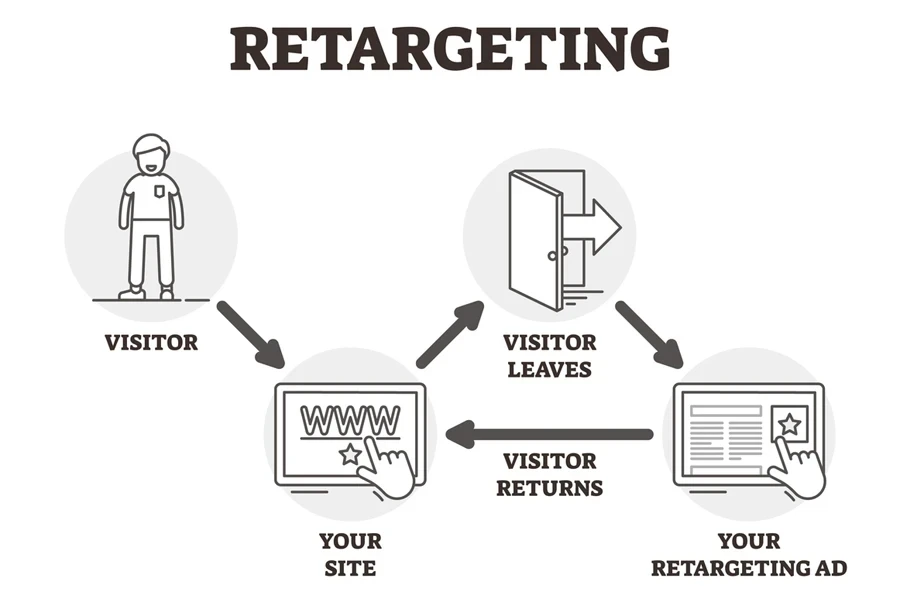Did you know that 92% of people who click on your website for the first time will not make a purchase? That’s a lot of lost potential revenue for your business. The good news is that you can bring back money by personalizing your advertising specifically to them through retargeting or remarketing.
Retargeting and remarketing are commonly interchangeable terms in digital marketing, and understanding their distinctiveness is vital if you are going to use them in your campaigns.
This guide will dissect the differences between these two strategies so that you can choose which technique best suits your needs.
Table of Contents
What is the difference between remarketing and retargeting?
What is remarketing?
How does remarketing work?
What is retargeting?
How does retargeting work?
The takeaway
What is the difference between remarketing and retargeting?

In simple terms, remarketing involves using email to reengage with customers who have already shown interest or transacted with your brand. Conversely, retargeting is a marketing strategy that displays paid ads to users based on a user’s activity with your website.
Remarketing and retargeting have different marketing goals. While retargeting focuses on moving not-yet customers down your sales funnel to convert them into paying customers, remarketing is more about re-engaging existing customers and increasing customer lifetime value (CLV).
Regarding similarities, remarketing, and retargeting are lead nurturing techniques that aim to support a holistic customer lifetime marketing plan. By strategically incorporating both online marketing approaches, you can reach target audiences already familiar with your brand, engage customers likely to buy, and create long-term brand awareness.
Moreover, both remarketing and retargeting utilize the benefits brought by the ability to collect and analyze data about online user behavior. This allows you to identify a specific target market that is interested in what you offer and then place your online ads where they are likely to spend the most time.
What is remarketing?

Remarketing is the reengagement of your existing customers through email marketing, an often-used marketing technique by modern-day business owners.
In fact, according to a recent study, at least 64% of small businesses use email marketing to reach their customers. Additionally, four out of five marketers prefer email over social media marketing.
This shows that email marketing is an undoubtedly effective digital marketing strategy and you can leverage it by using emails to re-engage customers with personalized messages that suit them depending on where they are in their journey to conversion.
Using remarketing techniques, you can collect data about visitor activity to your advantage. This can be done by tracking their past buying activity or actions on your website and using these behaviors to reach current or previous customers and revive their interest in your brand.
Some examples of marketing emails you can send to them include:
- Reminding customers of an abandoned cart
- Recommending products related to items they have bought in the past
- Sending an email after completing a purchase
- Contacting users to remind them of items in their wishlist
In contrast to retargeting, remarketing requires an email list. Still, remarketing can potentially increase the profitability of your current email list by utilizing the power of collected data.
How does remarketing work?

When building your remarketing campaigns, there are two tools that you can use which are pixels and lists.
Pixels for remarketing are codes that track a user’s journey on your website to provide information on the customer’s purchasing habits. This information can be used to customize the emails you plan to send to different users.
For example, a pixel can identify which customers have items left in their shopping carts, allowing you to strategically remind them that they still have items waiting for them to buy.
A remarketing list is an organized list of customers who visit your website and where they are in the sales journey. You can choose to categorize your users into different segments, such as:
- First-time buyers
- Frequent shoppers
- Users with items in their favorites or wishlist
- Customers with abandoned carts
For each of these groups you can be able to send an email that is relevant to their actions on your website.
Using the above marketing list as an example, the types of remarketing emails that suit them are:
- First-time buyers: Thank you email
- Frequent buyers: Related products, promotions, and upselling emails
- Users with items in their wishlist: Sale alert email
- Customers with items in their shopping carts: Cart abandonment email
You can automate your email marketing campaigns, meaning that your emails can be sent automatically to your customers at the right time. Remember always to follow email marketing best practices or else your efforts could push away customers instead of engaging with your business.
Some of the best email remarketing practices include keeping the marketing message simple and offering an incentive such as a discount or BOGO deal. This will boost the chances of your customers rebuilding a connection with your brand for an extended period.
What is retargeting?

While remarketing uses email to connect with past or existing customers, retargeting focuses on those who are aware of your brand but have yet to purchase. With this information, you can create ads that will be displayed to warm leads while browsing other websites.
A retargeting strategy allows you to target people who have visited your website or social media pages based on their online activity. When potential customers click on your site, a pixel tracks their online behavior and displays ads that are specific to them.
The good thing is that the ads displayed to them can appear on other websites, which means you can reach them even if they are not browsing your web pages. On top of that, retargeting does not require you to have the visitor’s email address or have them visit your website more than once.
How does retargeting work?

Like remarketing, retargeting uses pixels to track on-site and off-site activities. The difference is that remarketing focuses on your customers’ on-site activities, whereas retargeting shows ads to your users when they are away from your website.
This helps ensure that your customers are always aware of your brand’s existence, increasing their likelihood of buying from you when they have a similar in mind to what you are offering.
Ad display networks such as Google Ads and Meta Ads make retargeting possible. With Google Ads, your ads can be seen when users browse the millions of websites on the Google display network or other websites that Google owns, such as YouTube.
With Meta Ads, users can see your ads when surfing on Meta-owned social media platforms such as Facebook and Instagram.
When you sign in to any display advertising network, you are provided with a retargeting pixel specific to your website. Once users browse a website belonging to the relevant display ad network you have selected, the network can find the right retargeting ads to display based on their past online activity.
However, digital ads are not free. The provider charges based on models such as pay-per-click (PPC) or cost-per-mille (CPM).
In PPC advertising, you pay for the number of times users have clicked on your ad. CPM is charged based on the number of times your ad has been shown to an audience.
The takeaway
After understanding the difference between remarketing and retargeting, incorporating these strategies into your marketing mix depends on what problem you want to address. Retargeting works best with users who are not quite in the buying phase but have shown interest in your brand. On the other hand, remarketing reminds your customers that your brand exists and that you are always there when they need you.
Finally, remember to follow Alibaba.com Reads for the latest trends and updates in the world of ecommerce.




